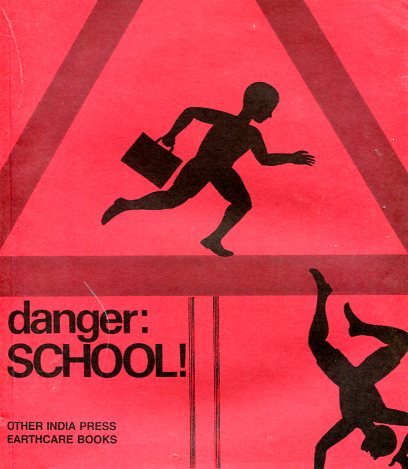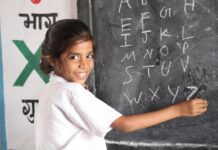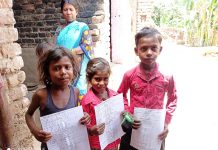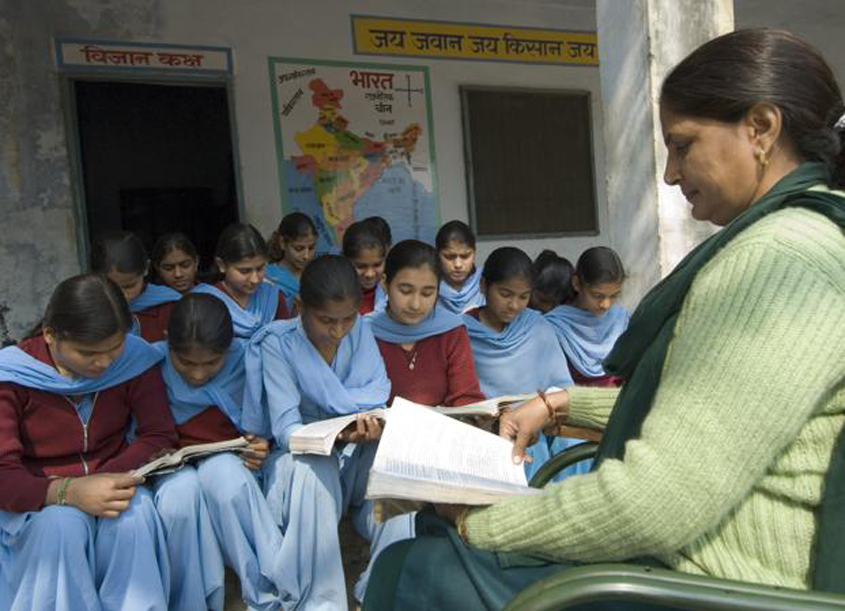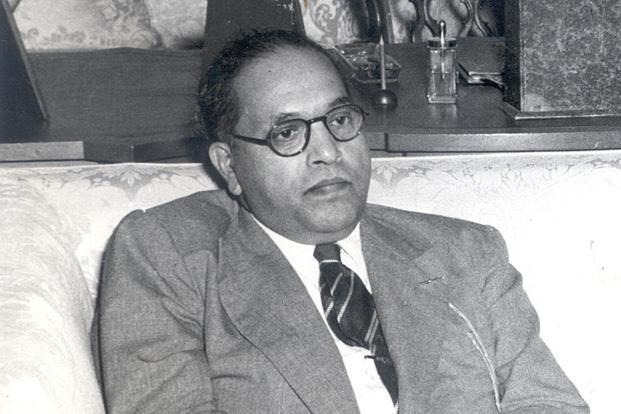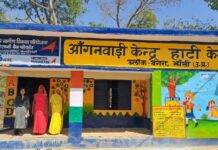Danger:School! The name of the book is enough the suggest the radical ideas it involves. It is a cartoon book that speaks about the apathy of the school system. It has been illustrated by Brazil’s celebrated cartoonist Claudius. The book is a remarkable documentation of the regimentation and artificiality of our schools.
This book has a serious and ironic approach to the schools and education structures. It is written with a viewpoint that anybody (who is interested in knowing the conditions and what is going on in these institutions), can easily read and understand the whole context. This book consist not just general views of the author but these views are also supported by various experiments’ results, research findings, and ideas of thinkers like Paulo Freire. If I talk about the format of the book, it is not just textual but visually appealing also. It is written in a comic format with a large number of visuals in the cartoon form, which makes this book more interesting and easy to read and understand. Using this comic format does not reduce the seriousness of the issues which has been discussed in the book, instead it is helpful to encourage those also who usually don’t find reading interesting.
As it is true that schools and education plays a very important part in our lives because it influences all other aspects of our lives, like social, political etc. So it is necessary that every individual should know what actually happen in these institutions because many times it happens that we look at the things in the same way which the politics and the dominating powers of the society want us to see and in that case we don’t understand the actual conditions. I have also experienced these types of things and notions of schooling in the case of my cousin, who is just in class-1. They live near to my house. Initially they used to visit us frequently but from past some time their visits has been reduced and whenever they came, my aunt usually come alone without my cousin. When I asked her about this then she said that he is studying at home with his Dadi. It gives us a clear picture of parents’ concern about their children’s studies and education. For them learning is only what happen in schools and through textbooks and that is all what is necessary for the child because it will decide the future career of that child, and what he experience in these days of his life by interacting with others and by interacting with the things by themselves other than the bookish and school learning is not learning at all for them. They consider it as a waste of time. They are having these notions and considerations about schools because the dominating powers had made them to think like that. They don’t question why career and schooling are interlinked and not career and knowledge? They want that their child should get more marks and he should get more years of schooling rather than more meaningful learning. This is what Tagore’s concerns also to some extent. He was also not happy with this idea of schooling and education, and that’s why he opened his institutions ( Shantiniketan, Sriniketan, and Visva- Bharti) for education which is different from these mechanistic forms of institutions. He was also in favor of endeavoring education to relate closely to life beyond the confines of the classroom. It was to teach and practice total activity, build up into life and relatedness into learning. But this does not usually happen in schools. This is what the author has also tried to bring the real picture of these institutions and the political ideas behind the generally prevalent notions of schooling. There are two characters present in the book that are having a dialogue about the role of schools and its impact on us. One of the characters may resemble the author and the other is someone who only has that picture of school which the socio-political forces want us to see (like my aunt in this case). So through this dialogue the author has tried to bring the reality of what actually happens in these institutions and also trying to remove the false impression which the other person have about these institutions, by critically looking at each layer of every aspect of these institutions.
This book is also able to illustrate the feelings, thoughts, and opinions of parents, teachers, and children about the stark but sad reality of the school system. It also has a vision of provoking thoughts in the readers and develops the need of looking at the things critically and creatively.
One thing which I found most interesting and true depiction of the reality was that, the system of school is showed like a machine, which have to perform various functions but it is not functioning properly. It has also showed that how this school machinery promotes inequality among learners, by labeling, ranking, and selective selection of students. If we look at it in the present context then we can see that the government had introduced Chunauti scheme in the schools which segregate the children in three categories of ‘Pratibha, Nishtha, and Vishwas’, based on their academic abilities to learn. When I discussed about this with teachers of schools and some parents, as a part of my study in B.El.Ed., I got to know that most of them were really happy with this scheme. But they are not seeing it as a negative impact on child’s mind about himself and his capabilities because of this labelling and selective selection. In my internship also all the classes were divided in two sections based on the performance of the children in the class. It has reduced the whole system to a machine where the input is segregated initially and based on that input our ideas of output will be decided.
This system also doesn’t give space to children’s experiences and their dreams. As in the book, “Experience and Education”, Dewey has also said that, ‘good education should have both a societal purpose and purpose for the learner’. For him the educators are responsible for organizing the subject matter in a way that it takes account of learners’ past experiences and then provide them with experiences which will help to open up, rather than shut down a person’s access to future growth experiences. So the learner should be provided with that kind of education with which they feel connected, make meaning, and also able to apply and use that knowledge meaningfully. But in reality it won’t happen usually. As during my internship in B.El.Ed., I have seen that one day the teacher had to cover a topic on weather and that was a rainy day and children were enjoying that weather through windows but when the teacher came they all had to sit on their seats and learn about weather from the book instead directly from outside which interest them more. Teacher could also enjoy that weather along with them and simultaneously have a discussion on the topic which she had prepared for that class and also relate it with children’s experiences. But in this mechanistic form of school system, all children are provided with some abstract knowledge with which they don’t feel connected and it becomes a burden for them which will only harm them like the parrot got harmed in the story, “The Parrot’s Training”, by Tagore. The parrot was also provided with that knowledge which was not meaningful for him and because of so much pressure and force to study he dies in the end. So to protect our children from this kind of situation where our inner being is filled with lots of information but we don’t feel alive anymore, Dewey has asked to change this mechanical system of schooling and education, and link it with the experiences of the learners to make it meaningful and not just a burden. That’s why I really like this part of the book where the author has attacked this mechanistic form of school structure and education, and he also tried to explain the problems present in this machine because of which it is not functioning properly.
This book has also attacks the concepts of similarity, forced discipline, control, uniformity, conformity, acceptance of authority, inequity, competition, politics and dominance in education system. It has also attacked the concept of ‘intelligence’. As usually it is a notion that those who go to school and getting more marks are more intelligent than those who don’t or getting low marks, but this is not the reality. School can help in attaining literacy but not necessarily intelligence. This is what Ambedkar has also said in his writings, “Franchise”, from the book, “The Essential Writings of Ambedkar”, by Valerian Rodrigues, that we cannot relate intelligence with schooling. If I look at it in the context of my internship experience, then I can say that there was a teacher who had some notions about children, that is, who is intelligent and who is not. So when I was doing operations of additions and subtractions in math class, there were some children who were able to solve those sums in their notebook or I can say they understood the steps for solving those sums. But there was a child also who was not able to solve those sums in her notebook but when we moved to the word problems then she was able to solve those word problems orally. It was because she used to go with her father for selling vegetables and she had this experience of dealing with money. So this is also intelligence. This child is also intelligent who was not able to solve the sums in the notebook but can solve orally. But the sad condition is that her knowledge is not recognized in the school, which makes her feel inferior and the things which are accepted or promoted by the school is very abstract for her and she feel excluded.
So these are some things which have been discussed in this book. It is a very insightful and a quick read about the state of school and education in the present context. What makes this book more interesting is that it questions the basic idea regarding school as well as education. It is a good book and a resource to open our mind to the reality of school system and provoke our thoughts and also helps us look at the things around us more critically.
Kalpana Sharma is working in the field of education. She is a postgraduate in Education from Ambedkar University Delhi.

